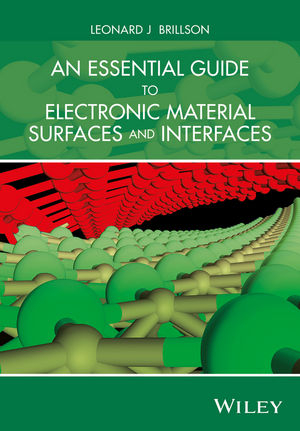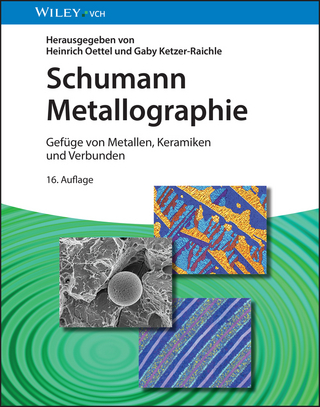
An Essential Guide to Electronic Material Surfaces and Interfaces
John Wiley & Sons Inc (Verlag)
9781119027119 (ISBN)
- Titel z.Zt. nicht lieferbar
- Versandkostenfrei
- Auch auf Rechnung
- Artikel merken
Starting with the fundamental electronic properties of semiconductors and electrical measurements of semiconductor interfaces, this text introduces students to the importance of characterizing and controlling macroscopic electrical properties by atomic-scale techniques. The chapters that follow present the full range of surface and interface techniques now being used to characterize electronic, optical, chemical, and structural properties of electronic materials, including semiconductors, insulators, nanostructures, and organics. The essential physics and chemistry underlying each technique is described in sufficient depth for students to master the fundamental principles, with numerous examples to illustrate the strengths and limitations for specific applications. As well as references to the most authoritative sources for broader discussions, the text includes internet links to additional examples, mathematical derivations, tables, and literature references for the advanced student, as well as professionals in these fields. This textbook fills a gap in the existing literature for an entry-level course that provides the physical properties, experimental techniques, and theoretical methods essential for students and professionals to understand and participate in solid-state electronics, physics, and materials science research.
An Essential Guide to Electronic Material Surfaces and Interfaces is an introductory-to-intermediate level textbook suitable for students of physics, electrical engineering, materials science, and other disciplines. It is essential reading for any student or professional engaged in surface and interface research, semiconductor processing, or electronic device design.
Leonard Brillson is a professor of Electrical & Computer Engineering, of Physics, and a Center for Materials Research Scholar at The Ohio State University in Columbus, OH, USA. Prior to that, he directed Xerox Corporation's Materials Research Laboratory and had responsibility for Xerox's long-range physical science and technology programs at the company's research headquarters in Rochester, N.Y. He is a Fellow of IEEE, AAAS, AVS, APS, and MRS and a former Governing Board member of the American Institute of Physics. Professor Brillson has authored over 350 scientific publications in solid-state physics, microelectronics, surface science and materials science and received numerous scientific awards, including the AVS Gaede-Langmuir Award and the National Science Foundation American Competitiveness and Innovation Fellowship for leadership in the field of electrical and computer engineering.
Preface xiii
About the Companion Websites xv
1. Why Surfaces and Interfaces of Electronic Materials 1
1.1 The Impact of Electronic Materials 1
1.2 Surface and Interface Importance as Electronics Shrink 1
1.3 Historical Background 5
1.4 Next Generation Electronics 10
1.5 Problems 10
References 11
Further Reading 13
2. Semiconductor Electronic and Optical Properties 14
2.1 The Semiconductor Band Gap 14
2.2 The Fermi Level and Energy Band Parameters 15
2.3 Band Bending at Semiconductor Surfaces and Interfaces 17
2.4 Surfaces and Interfaces in Electronic Devices 17
2.5 Effects of Localized States: Traps, Dipoles, and Barriers 19
2.6 Summary 19
2.7 Problems 20
References 20
Further Reading 21
3. Electrical Measurements of Surfaces and Interfaces 22
3.1 Sheet Resistance and Contact Resistivity 22
3.2 Contact Measurements: Schottky Barrier Overview 23
3.3 Heterojunction Band Offsets: Electrical Measurements 35
3.4 Summary 38
3.5 Problems 38
References 39
Further Reading 41
4. Localized States at Surfaces and Interfaces 42
4.1 Interface State Models 42
4.2 Intrinsic Surface States 43
4.3 Extrinsic Surface States 49
4.4 The Solid State Interface: Changing Perspectives 52
4.5 Problems 52
References 53
Further Reading 54
5. Ultrahigh Vacuum Technology 55
5.1 Ultrahigh Vacuum Chambers 55
5.2 Pumps 57
5.3 Manipulators 61
5.4 Gauges 61
5.5 Residual Gas Analysis 62
5.6 Deposition Sources 62
5.7 Deposition Monitors 64
5.8 Summary 65
5.9 Problems 65
References 65
Further Reading 66
6. Surface and Interface Analysis 67
6.1 Surface and Interface Techniques 67
6.2 Excited Electron Spectroscopies 70
6.3 Principles of Surface Sensitivity 72
6.4 Multi-technique UHV Chambers 73
6.5 Summary 75
6.6 Problems 75
References 75
Further Reading 75
7. Surface and Interface Spectroscopies 76
7.1 Photoemission Spectroscopy 76
7.2 Auger Electron Spectroscopy 89
7.3 Electron Energy Loss Spectroscopy 98
7.4 Rutherford Backscattering Spectrometry 104
7.5 Surface and Interface Technique Summary 112
7.6 Problems 113
References 116
Further Reading 117
8. Dynamical Depth-Dependent Analysis and Imaging 118
8.1 Ion Beam-Induced Surface Ablation 118
8.2 Auger Electron Spectroscopy 119
8.3 X-Ray Photoemission Spectroscopy 121
8.4 Secondary Ion Mass Spectrometry 122
8.5 Spectroscopic Imaging 128
8.6 Depth-Resolved and Imaging Summary 129
8.7 Problems 129
References 130
Further Reading 130
9. Electron Beam Diffraction and Microscopy of Atomic-Scale Geometrical Structure 131
9.1 Low Energy Electron Diffraction – Principles 131
9.2 Reflection High Energy Electron Diffraction 141
9.3 Scanning Electron Microscopy 144
9.4 Transmission Electron Microscopy 145
9.5 Electron Beam Diffraction and Microscopy Summary 148
9.6 Problems 149
References 150
Further Reading 151
10. Scanning Probe Techniques 152
10.1 Atomic Force Microscopy 152
10.2 Scanning Tunneling Microscopy 155
10.3 Ballistic Electron Energy Microscopy 162
10.4 Atomic Positioning 163
10.5 Summary 164
10.6 Problems 164
References 165
Further Reading 165
11. Optical Spectroscopies 166
11.1 Overview 166
11.2 Optical Absorption 166
11.3 Modulation Techniques 168
11.4 Multiple Surface Interaction Techniques 169
11.5 Spectroscopic Ellipsometry 171
11.6 Surface Enhanced Raman Spectroscopy 171
11.7 Surface Photoconductivity 174
11.8 Surface Photovoltage Spectroscopy 175
11.9 Photoluminescence Spectroscopy 180
11.10 Cathodoluminescence Spectroscopy 181
11.11 Summary 190
11.12 Problems 191
References 192
Further Reading 192
12. Electronic Material Surfaces 193
12.1 Geometric Structure 193
12.2 Chemical Structure 196
12.3 Electronic Structure 203
12.4 Summary 209
12.5 Problems 210
References 211
Further Reading 212
13. Surface Electronic Applications 213
13.1 Charge Transfer and Band Bending 213
13.2 Oxide Gas Sensors 216
13.3 Granular Gas Sensors 217
13.4 Nanowire Sensors 217
13.5 Chemical and Biosensors 217
13.6 Surface Electronic Temperature, Pressure, and Mass Sensors 220
13.7 Summary 220
13.8 Problems 221
References 222
Further Reading 222
14. Semiconductor Heterojunctions 223
14.1 Geometrical Structure 223
14.2 Chemical Structure 230
14.3 Electronic Structure 232
14.4 Conclusions 245
14.5 Problems 246
References 247
Further Reading 248
15. Metal–Semiconductor Interfaces 249
15.1 Overview 249
15.2 Metal–Semiconductor Interface Dipoles 249
15.3 Interface States 251
15.4 Self-Consistent Electrostatic Calculations 258
15.5 Experimental Schottky Barriers 259
15.6 Interface Barrier Height Engineering 264
15.7 Atomic-Scale Control 266
15.8 Summary 272
15.9 Problems 272
References 273
Further Reading 275
16. Next Generation Surfaces and Interfaces 276
16.1 Current Status 276
16.2 Current Device Challenges 278
16.3 Emerging Directions 279
16.4 The Essential Guide Conclusions 282
Appendices
Appendix A: Glossary of Commonly Used Symbols 283
Appendix B: Table of Acronyms 286
Appendix C: Table of Physical Constants and Conversion Factors 290
Appendix D: Semiconductor Properties 291
Index 293
| Erscheinungsdatum | 19.07.2016 |
|---|---|
| Verlagsort | New York |
| Sprache | englisch |
| Maße | 178 x 252 mm |
| Gewicht | 644 g |
| Themenwelt | Naturwissenschaften ► Chemie |
| Technik ► Elektrotechnik / Energietechnik | |
| Technik ► Maschinenbau | |
| ISBN-13 | 9781119027119 / 9781119027119 |
| Zustand | Neuware |
| Informationen gemäß Produktsicherheitsverordnung (GPSR) | |
| Haben Sie eine Frage zum Produkt? |
aus dem Bereich


